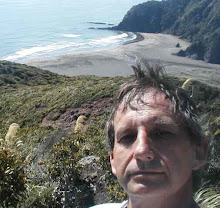 Some large bird has figured that there are tasty snacks to be found in the fairy martin nests. In the morning there will be a small pile of dirt and feathers on the ground and a large hole in the side of the nest. Magpies or crows I imagine.
Some large bird has figured that there are tasty snacks to be found in the fairy martin nests. In the morning there will be a small pile of dirt and feathers on the ground and a large hole in the side of the nest. Magpies or crows I imagine.Anyway, this doesn't seem to faze the martins. They simply rebuild the hole into a new entrance and carry on.
This would be functionally equivalent to a monster knocking its way through a wall of your house and devouring your children, and you then taking that as an opportunity to install a new picture window and deck for the nursery.

Then we have the magpie lark. A magpie lark is neither a magpie, or a lark. I guess whoever named it didnt have the imagination to come up with a new name, but decided that because this bird was colored like a magpie, and shaped like a lark, that magpie lark would be suitable. Well I suppose there are precedents. I mean a zebra fish is colored like a zebra and shaped like a fish. So there you go.
 Anyway, we have a resident magpie-lark. It has discovered that we drop breadcrumbs when we have lunch, and turns up right on cue. In fact it doesn't wait for us to drop crumbs, but utters this piercing cry "Pee-wee" to tell us that the food service in this establishment leaves a lot to be desired. The colloquial name for this bird is peewee, and in fact the cry doesnt sound at all like this, more like the sort of shriek from one of the female victims in the latest slasher movie, but then a cat doesnt say "Purr" either.
Anyway, we have a resident magpie-lark. It has discovered that we drop breadcrumbs when we have lunch, and turns up right on cue. In fact it doesn't wait for us to drop crumbs, but utters this piercing cry "Pee-wee" to tell us that the food service in this establishment leaves a lot to be desired. The colloquial name for this bird is peewee, and in fact the cry doesnt sound at all like this, more like the sort of shriek from one of the female victims in the latest slasher movie, but then a cat doesnt say "Purr" either.Incidently, I also learned that the Australian magpie (as opposed to the magpie lark) is no relation at all to the European magpie, but just looks a bit like it. Clearly the settlers had no imagination. Could have been worse, we could have ended up with "zebra bird".
























